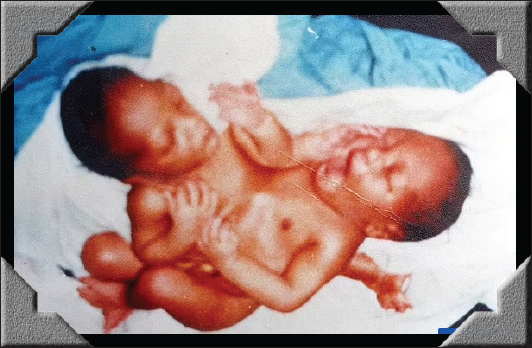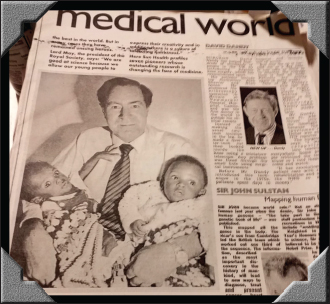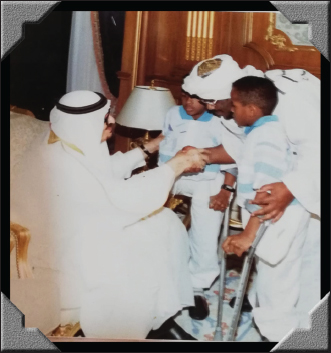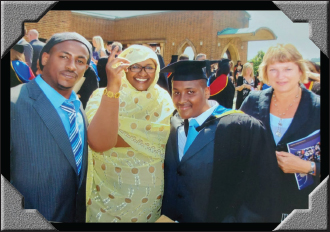
| Short Communication | ||
Sudan J Paed. 2023; 23(2): 248-251 SUDANESE JOURNAL OF PAEDIATRICS 2023; Vol 23, Issue No. 2 HISTORICAL PERSPECTIVES The story of the Sudanese conjoined twins, Hassan and HusseinYousif Eshag Omer Elhaj (1)(1) Chairman Academic Activities Committee, Council of Paediatrics and Child Health, Sudan Medical Specialization Board, Khartoum, Sudan Correspondence to: Yousif Eshag Omer Elhaj Chairman Academic Activities Committee, Council of Paediatrics and Child Health, Sudan Medical Specialization Board, Khartoum, Sudan. Email: elhagy1952 [at] gmail.com Received: 23 December 2020 | Accepted: 24 December 2023 How to cite this article: Elhaj YEO. The story of the Sudanese conjoined twins, Hassan and Hussein. Sudan J Paediatr. 2023;23(2):248–251. https://doi.org/10.24911/SJP.106-1703364387 © 2023 SUDANESE JOURNAL OF PAEDIATRICS
Conjoined twins have fascinated people for centuries and their surgical separation constitutes one of the most unique and rewarding experiences [1–5]. It is a very rare phenomenon that is estimated to occur between one in 50,000 births to 190,000 births. The incidence is said to be higher in Asia and Africa and it affects girls more at a ratio of 3:1. About half are stillborn and about a third die within 24 hours. The story of Hassan and Hussein, also known as the ‘Siamese Sudanese twins,’ born August 21st 1986 is one of triumph as it demonstrates the generosity of humanity and the miracle of modern medicine. This article will outline their story. Fayza and Mohammed Salih were teachers who lived in Kosti, a town on the White Nile, 259 km south of Sudan’s capital Khartoum, with their three healthy children. Apart from a large abdomen, there was nothing unusual about Fayza’s 4th pregnancy. Like most women in her situation at the time, there was no expectation for any prenatal imaging so she did not see any reason to do so. Labour began at term and Fayza was assisted by the local midwife who came to the house. It was immediately apparent that this was far from a normal pregnancy as it was the breech presentation. As the labour became too prolonged, Dr. Maawia Elsadig Hummeida, obstetrician, was consulted at the local hospital in Kosti. The first baby emerged as a footling breech presentation. Fayza, who was now haemorrhaging, needed an emergency caesarean section. She was transferred to Rabak hospital, about one hour away, since the operating room in Kosti was not equipped to deal with the complexity of the case, and was closed for sterilization that day. The mode of transport was a Toyota pick-up truck hired by Dr. Maawia and there was heavy rainfall. To make matters worse, there was a shortage of water and power cuts were frequent in Rabak. Water was sought from the neighbours and the operation was done using handheld light torches. The twins were born via caesarean section in good condition apart from their birth defect: they were conjoined chest to hip, with the adjacent legs forming a deformed third leg (Figure 1). Fayza was in a critical condition. She had a severe haemorrhage, which was further complicated by disseminated intravascular coagulation. She remained in an induced coma for 5 days while she received life-saving treatment. After that, the twins were presented to her. She was given solace that she was young and would have more children since her uterus was intact. Everyone prepared the parents for the worst. How could such a dire case possibly survive? The twins were transferred to Soba University Hospital in Khartoum for further care and investigations, under the care of late paediatric surgeon Mr. Ibrahim Abdel Aziz. Fayza continued her recovery at Rabak Hospital and joined them when they were 37 days old. By then the news of their birth had reached the international media and American as well as German organisations offered to adopt the twins. Both parents declined the offer, insisting that live or die, the twins would remain with them. The staff at Soba University Hospital made it clear that for the twins to be discharged, the family would have to relocate to Khartoum. Therefore, Fayza and Mohammed Salih rented a home in Umm Ombada, Omdurman, and left Kosti behind. The twins came home and survived despite their physical challenges. Fayza sent a photo of the twins to me, Dr. Yousif Eshag, a paediatrician (her brother) living and working in Saudi Arabia (King Saud Medical City, also known as Shemaisi Hospital, Riyadh). I sent the photo and request to the Kingdom of Saudi Arabia (KSA) monarch, His Majesty King Fahd bin Abdul Alaziz. This resulted in the humane and generous Royal Decree to sponsor the treatment of the twins in London. Fayza and Mohammed Salih received a telegram from me, informing them that they were to fly to England, where the team at the Great Ormond Street Hospital for Sick Children (GOSH) would conduct the surgery. The 3-month-old twins and their parents flew to the UK, supported by me to communicate on their behalf and handle their affairs. We arrived at Heathrow Airport on 8th December 1986 and went to the Saudi Arabian Embassy, where they were then driven to GOSH. They were greeted by the surgical team of Professor Lewis Spitz, the pioneering paediatric surgeon and international expert on conjoined twins, and Mr. Edward Kiely, Consultant Neonatal and Paediatric Surgeon. A series of surgeries subsequently followed in preparation for the main separation procedure. Fayza and Mohammed Salih were warned of the risks: there was an 80% chance that Hassan would not survive the separation. They were torn but decided that they owed it to the twins to give them a chance to lead normal lives. On Monday 26th April 1987 (age 7/12 months old), on the first day of the holy month of Ramadan, a huge team of surgeons and nurses worked for 17 hours to conduct the difficult procedure. Despite complications, to Fayza and Mohammed’s relief, the surgery was a success and both twins survived (Figure 2). In the recovery room, the twins’ blood pressure elevated and only settled when they were placed close to each other. This is a known phenomenon and is seen frequently when conjoined twins are separated. It is thought that this is due to separation anxiety and is often managed by bringing both twins in close proximity.
Figure 1. The conjoined twins’ initial photo.
Figure 2. Hassan and Hussein cradled in the surgeon’s arms (Professor Lewis Spitz); their story rejoiced in newspapers.
Figure 3. At the age of 10 years the twins Hassan and Hussein were received, accompanied by their father Mohammed Salih, by the late His Majesty King Fahd bin Abdul Alaziz at Al-Safa Palace in Makkah. They expressed their sincere gratitude and that they are forever grateful to His Majesty.
Figure 4. During the graduation day of Hassan (second from right) with his mother Fayza Eshag (middle) and twin Hussein (first from left). Hassan graduated from Roehampton University with a BA (Hons) in Media and Photography, and Hussein graduated from Kingston University with a BA (Hons) in English Language and Communication with Creative Writing. Hassan and Hussein remained in hospital for 8 months where they underwent subsequent surgeries and received additional therapies to aid them in their recovery. At age 9 months, they went home for the first time. Fayza and Mohammed Salih moved the other siblings to the UK, where they have resided since. The twins continued to receive regular check-ups and surgeries. Continued support was offered from the Saudi Embassy in the UK. At the age of 10 years, they were invited to KSA and were received by the late His Majesty King Fahd bin Abdul Alaziz at Al-Safa Palace in Makkah (Figure 3). They expressed their sincere gratitude. They also performed Umrah and visited Medina. Today the twins are 37 years old and are still living together and have a deep connection [6]. They periodically need new artificial limbs (each twin has one leg as the deformed ‘third’ leg was amputated), which they receive from the team at Roehampton Hospital. While they do make use of their artificial leg, they are most comfortable getting around on their crutches. They both have university degrees and have ambitions for the future. Hassan graduated from Roehampton University with a BA (Hons) in Media and Photography (Figure 4), and Hussein graduated from Kingston University with a BA (Hons) in English Language and Communication with Creative Writing. CONFLICT OF INTERESTThere are no conflicts of interest stated by the author. FUNDINGNone. ETHICS APPROVALConsent to participate and photography was taken from Hassan and Hussain, and their parents. REFERENCES
| ||
| How to Cite this Article |
| Pubmed Style Yousif Eshag Omer Elhaj. The story of the Sudanese Conjoined twins, Hassan and Hussein. Sudan J Paed. 2023; 23(2): 248-251. doi:10.24911/SJP.106-1703364387 Web Style Yousif Eshag Omer Elhaj. The story of the Sudanese Conjoined twins, Hassan and Hussein. https://sudanjp.com//?mno=182451 [Access: January 22, 2025]. doi:10.24911/SJP.106-1703364387 AMA (American Medical Association) Style Yousif Eshag Omer Elhaj. The story of the Sudanese Conjoined twins, Hassan and Hussein. Sudan J Paed. 2023; 23(2): 248-251. doi:10.24911/SJP.106-1703364387 Vancouver/ICMJE Style Yousif Eshag Omer Elhaj. The story of the Sudanese Conjoined twins, Hassan and Hussein. Sudan J Paed. (2023), [cited January 22, 2025]; 23(2): 248-251. doi:10.24911/SJP.106-1703364387 Harvard Style Yousif Eshag Omer Elhaj (2023) The story of the Sudanese Conjoined twins, Hassan and Hussein. Sudan J Paed, 23 (2), 248-251. doi:10.24911/SJP.106-1703364387 Turabian Style Yousif Eshag Omer Elhaj. 2023. The story of the Sudanese Conjoined twins, Hassan and Hussein. Sudanese Journal of Paediatrics, 23 (2), 248-251. doi:10.24911/SJP.106-1703364387 Chicago Style Yousif Eshag Omer Elhaj. "The story of the Sudanese Conjoined twins, Hassan and Hussein." Sudanese Journal of Paediatrics 23 (2023), 248-251. doi:10.24911/SJP.106-1703364387 MLA (The Modern Language Association) Style Yousif Eshag Omer Elhaj. "The story of the Sudanese Conjoined twins, Hassan and Hussein." Sudanese Journal of Paediatrics 23.2 (2023), 248-251. Print. doi:10.24911/SJP.106-1703364387 APA (American Psychological Association) Style Yousif Eshag Omer Elhaj (2023) The story of the Sudanese Conjoined twins, Hassan and Hussein. Sudanese Journal of Paediatrics, 23 (2), 248-251. doi:10.24911/SJP.106-1703364387 |
Nagwa Salih, Ishag Eisa, Daresalam Ishag, Intisar Ibrahim, Sulafa Ali
Sudan J Paed. 2018; 18(1): 24-27
» Abstract » doi: 10.24911/SJP.2018.1.4
Siba Prosad Paul, Emily Natasha Kirkham, Katherine Amy Hawton, Paul Anthony Mannix
Sudan J Paed. 2018; 18(2): 5-14
» Abstract » doi: 10.24911/SJP.106-1519511375
Inaam Noureldyme Mohammed, Soad Abdalaziz Suliman, Maha A Elseed, Ahlam Abdalrhman Hamed, Mohamed Osman Babiker, Shaimaa Osman Taha
Sudan J Paed. 2018; 18(1): 48-56
» Abstract » doi: 10.24911/SJP.2018.1.7
Adnan Mahmmood Usmani; Sultan Ayoub Meo
Sudan J Paed. 2011; 11(1): 6-7
» Abstract
Mustafa Abdalla M. Salih, Mohammed Osman Swar
Sudan J Paed. 2018; 18(1): 2-5
» Abstract » doi: 10.24911/SJP.2018.1.1
Amir Babiker, Afnan Alawi, Mohsen Al Atawi, Ibrahim Al Alwan
Sudan J Paed. 2020; 20(1): 13-19
» Abstract » doi: 10.24911/SJP.106-1587138942
Hafsa Raheel, Shabana Tharkar
Sudan J Paed. 2018; 18(1): 28-38
» Abstract » doi: 10.24911/SJP.2018.1.5
Anita Mehta, Arvind Kumar Rathi, Komal Prasad Kushwaha, Abhishek Singh
Sudan J Paed. 2018; 18(1): 39-47
» Abstract » doi: 10.24911/SJP.2018.1.6
Majid Alfadhel, Amir Babiker
Sudan J Paed. 2018; 18(1): 10-23
» Abstract » doi: 10.24911/SJP.2018.1.3
Bashir Abdrhman Bashir, Suhair Abdrahim Othman
Sudan J Paed. 2019; 19(2): 81-83
» Abstract » doi: 10.24911/SJP.106-1566075225
Amir Babiker, Mohammed Al Dubayee
Sudan J Paed. 2017; 17(2): 11-20
» Abstract » doi: 10.24911/SJP.2017.2.12
Cited : 8 times [Click to see citing articles]
Mustafa Abdalla M Salih; Satti Abdelrahim Satti
Sudan J Paed. 2011; 11(2): 4-5
» Abstract
Cited : 4 times [Click to see citing articles]
Hasan Awadalla Hashim, Eltigani Mohamed Ahmed Ali
Sudan J Paed. 2017; 17(2): 35-41
» Abstract » doi: 10.24911/SJP.2017.2.4
Cited : 4 times [Click to see citing articles]
Amir Babiker, Afnan Alawi, Mohsen Al Atawi, Ibrahim Al Alwan
Sudan J Paed. 2020; 20(1): 13-19
» Abstract » doi: 10.24911/SJP.106-1587138942
Cited : 4 times [Click to see citing articles]
Mutasim I. Khalil, Mustafa A. Salih, Ali A. Mustafa
Sudan J Paed. 2020; 20(1): 10-12
» Abstract » doi: 10.24911/SJP.1061585398078
Cited : 4 times [Click to see citing articles]











